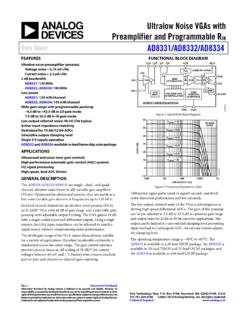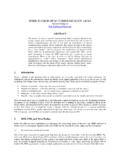Transcription of Ultra Low Noise, High Performance, Zero IF …
1 Ultra low noise , High Performance, Zero IF Quadrature product Detector and preamplifier By Dan Tayloe Summary: The Tayloe Quadrature product Detector has four unique properties: - Less than 1 db of conversion loss - Free tracking bandpass selectivity (Q = 3,500 at 7 MHz), with a user definable bandwidth - A high 3rd order intercept (+30 dbm). - An extremely compact and simple design compared to other zero IF I-Q quadrature detectors . The product detector's upper frequency limit is set by the ability of a FET to be turned on for only a quarter cycle of the incoming RF being converted to baseband.
2 The maximum useful frequency for this detector readily extends to at least 10 GHz. The companion I-Q quadrature upconverter is extremely simple and allows the conversion of baseband quadrature signals to RF with negligible conversion loss. Tayloe Quadrature product Detector Basic Detector Operation The basic product detector is shown in figure # 1. Note that the detector is extremely simple in design. The incoming RF signal is routed via a common resistor, R and a commutating RF multiplexer, to one of four detection capacitors, C.
3 This 1-of-four multiplexer is commutated at a rate of four times the desired detection frequency. The 4x commutating frequency causes each capacitor to see a quarter cycle of the input RF at the desired detection frequency. Mixers generally produce sum and difference outputs. In zero IF applications, the difference frequency is used, while the sum is thrown away. Therefore, the conversion loss using an ideal mixer is at least 3 db, with a typical conversion loss of 4-6 db in practice. Conversely, this design is not a mixer, but rather can best be described as a switching integrator , producing only a difference frequency.
4 The input R and a particular detection C act together as an integrator, averaging the signal over the quarter cycle sample to the detection capacitor. Figure # 2 shows a sine wave that happens to be the same frequency as the detector is tuned to, and with the phasing alignment that will produce a maximum positive voltage on the first capacitor, zero volts on the second and fourth capacitor, and a maximum negative voltage on the third capacitor. Performing an integration over the peak quarter cycle of this sine wave shows that the maximum detected voltage will be approximately times the peak voltage of the sine wave.
5 Hence, the detection loss is about db. If the frequency of the incoming signal is shifted slightly from being exactly the detection frequency, the resulting voltages on the detection capacitors will no longer be stationary, but will drift with time, following the difference frequency between the incoming signal and the detection frequency. In short, the first capacitor becomes a baseband product detector sampling at 0 degrees, with the other detection capacitors detecting at 90, 180, and 270 degrees respectively.
6 2. The 180 and 270 degree outputs carry information that is redundant with the 0 and 90 degree outputs. Therefore the 0 and 180 degree outputs can be summed differentially to produce a single composite In- phase ( I ) signal and 90 and 270 can be likewise combined to form a Quadrature ( Q ) signal. See figure # 3. This differential summing can be performed using low noise op-amps or instrumentation amps. Detection Bandwidth The detector has a frequency roll off that can be set by properly selecting R and C.
7 Together R and C act like a lowpass filter at baseband. However, all components of the series resistance must be taken into consideration when computing the frequency roll off. See figure # 4. Notice that the equivalent series resistance is not just the filter input R, but also includes the system input impedance, Rsys, and the switch resistance Rswitch. Since each detector capacitor sees the input for only a quarter of the time, the effective resistance used in the low pass filter calculation is: 4 times (Rsys + R + Rswitch).
8 3. Suppose a 1 KHz detection bandwidth is desired for a 7 MHz receiver. If Rsys is 50 ohms, and both R and Rswitch are assumed to be zero, a detection C of uf yields a 3 db lowpass filter bandwidth of 1 KHz. Notice that the actual detection bandwidth will be 2 KHz since the lowpass roll off will extend to both sides of the center detection frequency. However, a selection of uf will cause the edges to be 3 db down, so the actual selection of C will depend upon a potential trade off in the wide band adjacent channel rejection and the roll off of the actual signal at the detection edge.
9 Note that the detection bandwidth tracks with the frequency the detector is set to. Even though the roll off represents only a single R/C pole at base band, a 2 KHz tracking bandwidth at 7 MHz is equivalent to a single pole tuned circuit Q of 3500. At 28 MHz, the same 2 KHz tracking bandwidth yields a Q of 14,000. It is typical that a receiver is designed to select one signal out of a number of signals spread out over a desired frequency spectrum. In order for the detector and subsequent stages to guard against undesired out of band signals, bandpass filtering is often used as the first stage in a receiver's front end.
10 This bandpass filtering is normally fixed tuned and as such provides no in band protection from other signals within the desired frequency band. In contrast, the selectivity provided by this detector is centered about the detection frequency. As such the selectivity it provides is superior to that provided by band wide bandpass filtering, providing some margin of free selectivity against both adjacent channel and out of band signals. In some cases, this built in selectivity may significantly reduce or even negate the need for any receiver front end bandpass filtering and it associated additional insertion loss.








